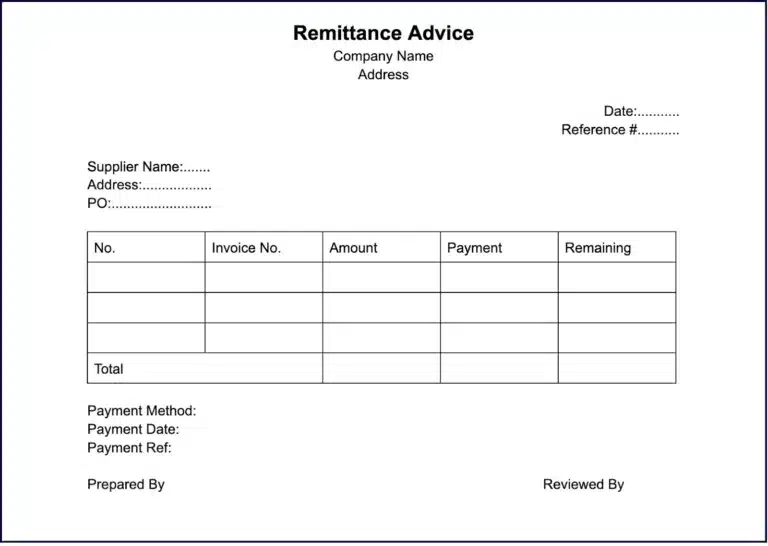
Learn how to expertly execute global payments for streamlined accounts payable and business efficiency.
Fill out the form to get your free eBook.

There are numerous options for paying international suppliers, from prepaid debit cards to international ACH to wire transfers and more. Each has benefits and drawbacks that impact the satisfaction of your suppliers and the workload of your finance team Download the eBook to discover: 1. The current state of supplier payments 2. Today’s top global payment methods 3. Comparing Wire Transfers, Domestic ACH, Global ACH, Paper Checks, Prepaid Debit Cards, and PayPal 4. How automation enables multiple payment methods
Remittance advice sounds complex, but it’s a simple concept that goes hand in hand with paying invoices. This article focuses on supplier-customer financial transactions in businesses, although it highlights some other use cases.
A supplier invoices a customer in detail and requests payment for goods or services. The customer then sends remittance advice—either manually or through an automated system—to indicate a payment is being made.
What is Remittance Advice?
Remittance advice is a proof of payment letter sent by a customer to a supplier confirming that they have paid their invoice. It may be an electronic notification or a paper-based document.
Key Takeaways
- A remittance advice advises the payee that the payer is making a payment.
- Businesses receiving the remittance advice will receive a customer’s payment by accompanying check, or can expect an EFT for an instant payment or initiated payment to be received within days.
- Sellers use remittance advices to record and reconcile accounts receivable collections. The customer isn’t required to furnish remittance advice to the seller when paying bills.
A remittance advice can specify payment information, including invoice dates, invoice numbers, payment method, payment amount, and date paid.
Sometimes, the payment is sent with the remittance advice if they pay by check. Electronic remittance advices for payments using EFTs (like ACH payments through the Automated Clearing House) are created automatically when payments are processed.
For customers and suppliers, remittance advice adds clarity and security to invoice processing, accounts payable, and accounts receivable. To “remit” a payment is simply to send it. Think of any domestic or international payment or electronic funds transfer for businesses or individuals.
Remittance advice documents confirm that this remittance has happened or will happen soon.
For AP teams, especially those processing high volumes of payments, remittance advice adds clarity and reduces time spent matching payments to invoices.
Why Remittance Advice Matters
Remittance advice is essential because it alerts suppliers that follow-up is required when expected customer payments aren’t received, aids accurate record-keeping, facilitates cash application processes, and assists in reconciling payments with outstanding invoices.
Benefits :
- Reduces confusion
- Aids cash application
- Improves reconciliation
- Prevents payment follow-ups
What Does Remittance Advice Look Like?
Remittance advice notifies the recipient of a payment, including the details. Paper remittances include a detailed check stub, perforated invoice, or billing account statement section detached and mailed with the payment, indicating the amount paid. For example, if the customer pays by check, the payment may be sent with a remittance slip.
A well-structured remittance advice should contain:
- Customer and supplier details
- Payment date
- Payment reference number
- Amount paid
- Invoice numbers and invoice amounts, and/or account numbers
- Amount applied for partial invoice payments
- Credit memo numbers and amounts
- Early payment discounts applied
- Outstanding balance
- Any additional payment details
Tip: Use a standardized remittance format across entities to reduce errors and streamline reconciliation.
An Example of Remittance Advice

How Sellers Process Remittance Advice
When a seller gets remittance advice from their customer, they run through a detailed process to make sure the payment was received properly. The seller:
- Receives a detailed bank account deposit
- Enters or reviews an automatic software transaction to record the customer’s payment
- Debits (increases) the cash account
- Credits (reduces) accounts receivable in the customer’s account, applying the payment to specific invoices
- Researches and follows up on any payment discrepancies
- Runs and reviews accounts receivable aging report by customer
Types of Remittance Advice
Manual Formats
- Check Stub: Document with the invoice number(s) and amount paid.
- Perforated Invoice: The customer detaches perforated and removable remittance advice from the invoice to return the document to the payee with their payment.
- Scannable Slip: The supplier can scan the remittance advice when payment is received for electronic system processing.
Electronic Formats
- Email: When payment occurs, the payer emails the remittance advice to the recipient through a computer system.
- EDI: Businesses or health care insurers processing large batch payments can send remittance advices to suppliers or payees through an EDI system.
- PDF: Payers can send the payee a PDF file as a remittance advice.
Modern AP solutions support all formats and can ingest EDI/XML/PDF inputs through OCR and Smart Scan tools.
Remittance advice is used to notify the payee that the payment has been made through a bank remittance or other form of EFT, like credit or debit cards, PayPal, or another digital wallet app. Bank remittances are payment transfers between bank accounts that may be used to pay supplier invoices via ACH, global ACH like SEPA, wire transfers, or paper checks.
An inward remittance is money received from a foreign bank on behalf of its customer making the payment. When an inward remittance is made, the sender should send the recipient a detailed remittance advice to alert them that the payment is happening.
Remittance Advice vs. Invoice vs. Receipt
| Document | Sent By | Purpose | Timing |
|---|---|---|---|
| Invoice | Seller | Requests payment | Before payment |
| Remittance Advice | Buyer | Confirms payment sent | After payment |
| Receipt | Seller | Confirms payment received | After payment |
Common Challenges in Managing and Processing Remittance Advice
Accounts receivable teams receiving remittance advice from customers face these common issues:
- Incomplete or inaccurate information: The remittance advice may not provide all the needed information or may have errors.
- Delayed or lost remittance advice: When a payment is received before a remittance advice, the AR team will have to perform time-consuming research to determine which invoices the customer is paying. It’s essential to promptly record received payments in the system and reduce the customer’s accounts receivable balance.
- Mismatched payments: The payment received by the customer may not be assigned to the correct invoices or agree in total with outstanding invoice balances requiring payment. This requires accounts receivable staff research and reconciliation.
- Communication challenges: The customer may not recognize the importance of sending a detailed remittance advice to suppliers to inform them of the payment status when payments are made.
- Compatibility issues between different accounting systems: The format of the remittance advice sent by the payer’s system may not be compatible with that of the system used by the receiver’s accounts receivable department. This may require additional manual steps when processing remittance advices
Want to simplify global remittance advice and payment workflows?
Choosing different global payment methods for your business can be cost-effective and ensure payees receive remittance advice.
Remittance Advice in Different Industries
Remittance advice is adapted to fit the workflows and regulations of different industries.
1) Healthcare Remittance Advice (ERA and SPR)
As a healthcare industry example, automated EDI electronic billing systems (regulated by HIPAA privacy), including those used by CMS (CMS.gov) for Medicare, create an Electronic Remit Advice (ERA). The Standard Paper Remit (SPR) is a paper equivalent to the ERA. The ERA provides detailed information about claims payments or denials.
The itemized Electronic Remit Advice is sent to the provider with payment details and final claim adjudication information, using line-item standard claim codes determined through health claims processing.
The three types of ERA adjustment codes provided as additional information are:
- The claim adjustment group code (Group Code), which assigns
- Contractual Obligation of the unpaid claim balance to the medical service providers
- Amount of Patient Responsibility for payment to the patient
- Claim adjustment reason code (CARC)
- Remittance advice remark code (RARC)
2) Retail Remittance Advice
Customers may make real-time online payments when purchasing from the retail industry, including e-commerce stores or websites. An instant sales receipt for cash, debit card, or credit card payments may replace the need for using a remittance advice. When customers have credit accounts for sales going through the seller’s accounts receivable system, sending a remittance advice that identifies their customer account number and payment details is advisable.
3) Manufacturing Remittance Advice
Manufacturing companies use standard remittance advice with their contact information and customer account number, with details including invoice numbers and invoice dates, balance due on invoices, payment method, and date paid. Manufacturers may issue monthly account statements to their customers.
In regulated or high-volume industries, automating remittance processing ensures compliance and saves hours of manual reconciliation.
Frequently Asked Questions
Is Sending Remittance Advice Required?
Customers are not required to send remittance advice to suppliers, but it is best practice. The senders do their due diligence by notifying the supplier that an invoice has been paid. For the seller, it eliminates confusion over bill payments.
If there are issues with the account or transaction, the remittance also reveals the step in the payment process where something went wrong. If a customer has paid an invoice and sent remittance advice, but the seller has not received the funds, the sender can contact the payment issuer to see if there has been a delay or if the payment was processed incorrectly.
Is a Remittance Advice Proof of Payment?
Not in all cases. A remittance advice is a notification to the payee that a payment was sent. The payment may not reach the intended receiver, which is why remittance advice is important to alert the payee that follow-up is required.
For example, wire transfer funds don’t always reach the recipient because of information errors or problems completing a global transaction. Auditors don’t rely on payment remittance advice as proof of payment to confirm the existence of a cash receipt—for that, they go by the transactions in the ledger and the bank statement.
What is Remittance Advice Used For?
Remittance advice informs the recipient that a payment has been made and helps them match it to outstanding invoices.
Is Remittance Advice Mandatory?
No, but it is a best practice for businesses issuing payments to multiple suppliers or issuing batch payments.
What’s the Difference Between Remittance Advice and an Invoice?
An invoice requests payment; remittance advice confirms a payment has been sent.
How do Businesses Typically Send Remittance Advice?
Via email, online portals, or automated ERP integrations—depending on scale and systems.
Final Thoughts
Remittance advice can add more clarity to complex transactions and keep accountants better organized. A statement of payments remitted is helpful in the short term to make sure invoices are paid month to month, as well as in the long run when it comes to reviewing the books for quarterly and year-end reporting.
Many businesses opt for automated solutions, including automated invoice processing, to streamline remittance delivery, especially in high-volume or global payment scenarios. Learn more about methods for making global business payment remittances to accompany with remittance advice.
